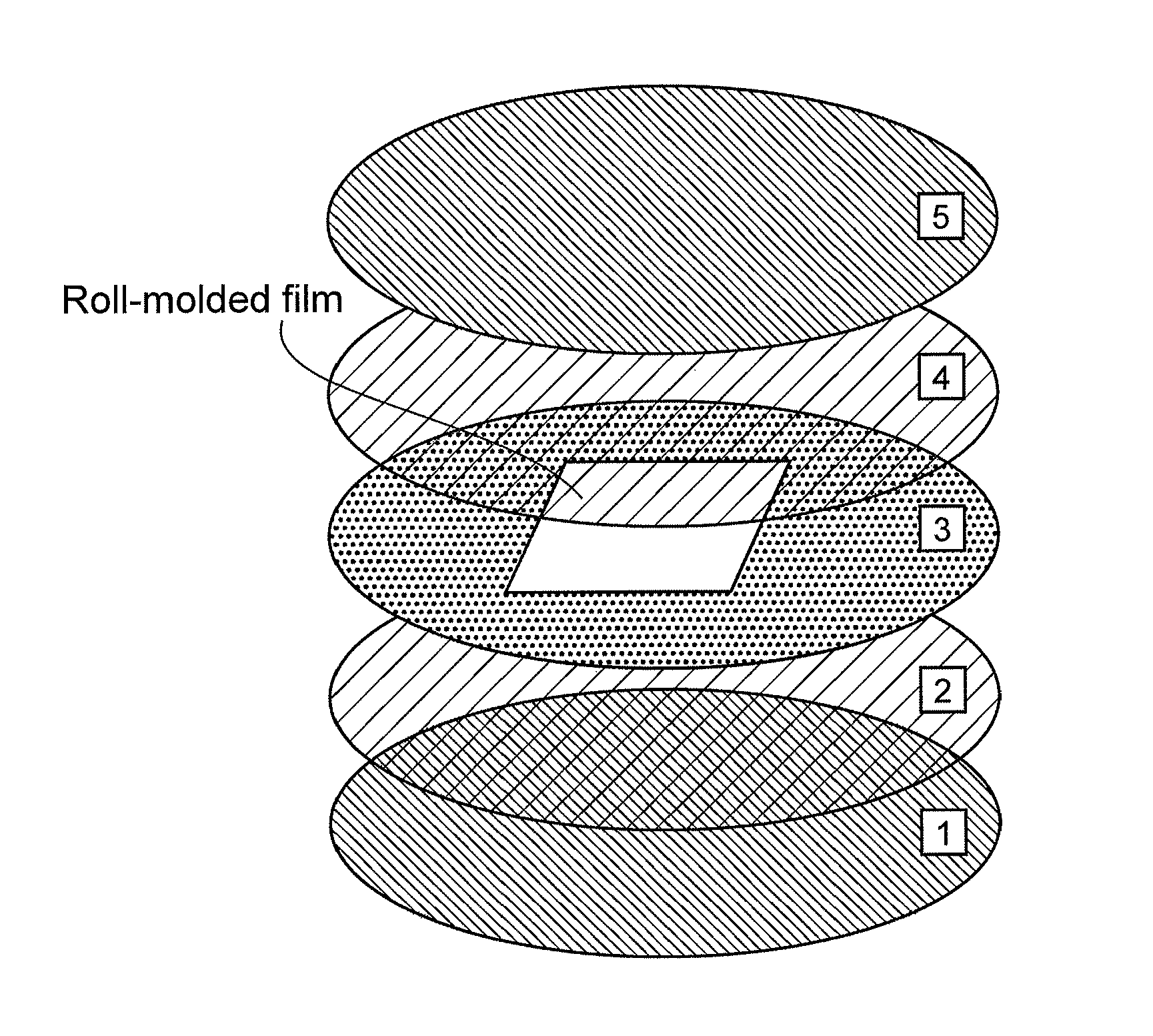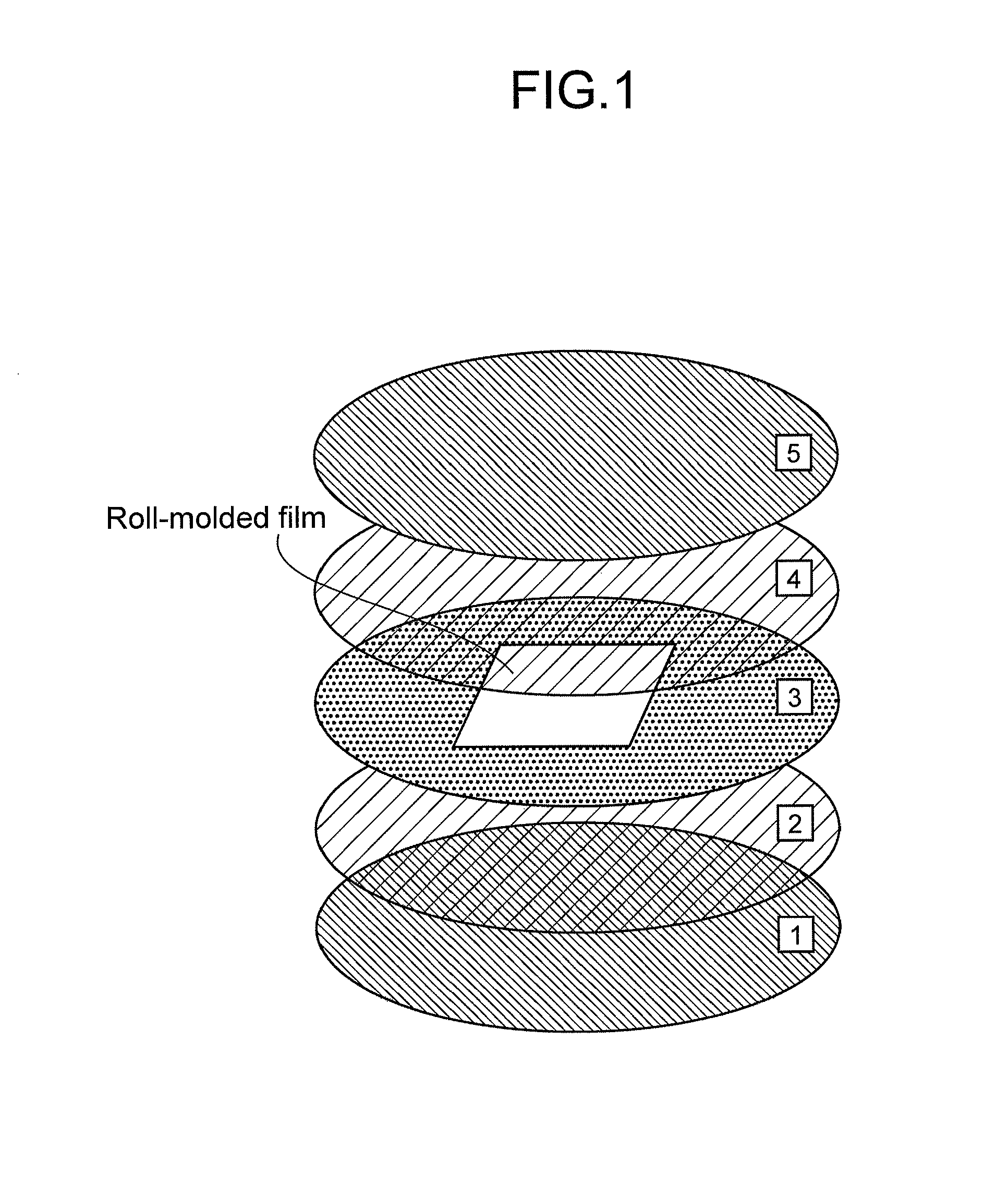Method for producing ultra-high-molecular-weight polyethylene porous membrane, method for producing ultra-high-molecular-weight polytheylene film, and porous membrane and film obtained by these methods
a technology of polyethylene porous membrane and ultra-high molecular weight, which is applied in the direction of cell components, cell component details, manufacturing tools, etc., can solve the problems of difficult stably molding a film, environmental load, health problems of workers, etc., and achieve high gas permeability, easy production, and high uniformity
- Summary
- Abstract
- Description
- Claims
- Application Information
AI Technical Summary
Benefits of technology
Problems solved by technology
Method used
Image
Examples
example 1-1
Roll-Molding
[0143]Roll-molding was performed according to JP-A No. 2003-165155 at 145° C. and a rotating speed of rolls of 3 m / min by using polyethylene polymer powder (viscosity average molecular weight: 3.5×106; Hizex Million 340M; manufactured by Mitsui Chemicals Inc.; particle diameter: 150 μm), followed by press-molding under the following conditions.
Press-Molding
[0144]As illustrated in FIG. 1, a polyimide film (2) for mould-releasing having a thickness of 125 μm was placed on a disk-shaped stainless steel plate (1) having a diameter of 110 mmφ and a thickness of 2 mm; a disk-shaped stainless steel plate (3) having a diameter of 110 mmφ and a thickness of 0.25 mm in which a 70 mm×70 mm rectangular window was cut was placed thereon; four 70 mm×70 mm films, which were cut from the film obtained by roll-molding as described above and having a thickness of about 75 μm, were stacked in the rectangular window so as to have roll directions alternate to (perpendicular to) each other. A...
example 1-2
[0150]The rolled-pressed film, obtained in the same manner as in Example 1-1, was cut into a 25 mm×25 mm square shape (unstretched: 1×1 times). By using a planar expanding stretching machine (manufactured by Island Industry Co., Ltd.) equipped with an air chuck mechanism, the cut film was maintained at 150° C., which was higher than the melting point thereof, for 5 minutes and simultaneously biaxially stretched to 12×12 times in the longitudinal and transverse directions while maintaining the temperature. Next, “the shrinking treatment” was performed to 6×6 times while maintaining the temperature at 150° C. Furthermore, the film was maintained in this state for 5 minutes to perform an annealing treatment, and was cooled to room temperature to fix a lamellar structure. The thickness of the film was 20 μm.
[0151]Next, the film was simultaneously biaxially stretched by 1.75×1.75 times (total stretch ratio: 10.5×10.5 times) at 155° C. to perform the pore-forming treatment, was cooled to ...
example 2-1
[0153]A porous membrane was produced in the same manner as in Example 1-1 using the stretched and shrunk film, which was obtained by simultaneously biaxially stretching the film at 150° C. to 7×7 times; shrinking the film to 4×4 times while maintaining the temperature at 150° C.; annealing the film at 150° C.; and cooling the film to room temperature, except that sequential stretching was performed at 155° C. as the pore-forming step by stretching. In the sequential biaxial stretching which was a pore-forming step, stretching was performed by 1.75 times in the longitudinal direction while fixing the film in the transverse direction, and then stretching was performed by 1.75 times in the transverse direction (total stretch ratio: 7×7 times). The oxygen permeability coefficient of the obtained porous membrane was 2.73×10−9 cm3(STP)cm / (cm2·s·cmHg) when measured in the same manner as in Example 1-1.
PUM
| Property | Measurement | Unit |
|---|---|---|
| melting point | aaaaa | aaaaa |
| temperature | aaaaa | aaaaa |
| temperature | aaaaa | aaaaa |
Abstract
Description
Claims
Application Information
 Login to View More
Login to View More - R&D
- Intellectual Property
- Life Sciences
- Materials
- Tech Scout
- Unparalleled Data Quality
- Higher Quality Content
- 60% Fewer Hallucinations
Browse by: Latest US Patents, China's latest patents, Technical Efficacy Thesaurus, Application Domain, Technology Topic, Popular Technical Reports.
© 2025 PatSnap. All rights reserved.Legal|Privacy policy|Modern Slavery Act Transparency Statement|Sitemap|About US| Contact US: help@patsnap.com



